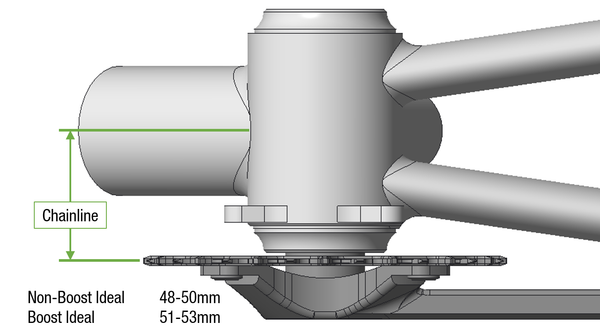Understanding Chainline for Optimal 1X Conversions (Boost and Non-Boost)
Have you converted your bike to 1X in the past 5 years? If so, your chainline could be causing premature drivetrain wear.
Find out how to optimize your setup and save money.
What is chainline?
Chainline is the distance between the centerline of your frame and the average centerline of your chainring(s). For 1X this is easy – If the center of your chainring teeth is 49mm from the centerline of your frame then your chainline is 49mm. It gets slightly more difficult if you have multiple front chainrings. A 2X crank with tooth centerlines that are located at 45mm (smaller ring) and 53mm (larger ring) would have a 49mm 2X chainline. Unfortunately, if you were to remove these rings and install a standard narrow-wide ring the resulting 1X chainline would be about 52mm. This is 3mm wider than the ideal 49mm 1X chainline but makes up the vast majority of all 1X conversions. At OneUp Components we're 100% focused on 1X drivetrains. Below is a detailed guide to help you get perfect chainline.

Bicycle chainline is one of the most overlooked aspects of drivetrain setup for 1X systems. This is understandable since before 2009 mountain cranksets were a pretty standardized piece of equipment. As such we haven't been conditioned to think about it - That has all changed.
Symptoms of poor 1X chainline
- Premature wear to chains, chainrings and cassettes
- Grinding, rough or noisy pedalling
- Dropped chains
- Chains that derail when you backpedal while in the largest cassette cog
- Rubbing between chain ring and frame
Some history
- Between 2000 and 2009 most mountain bikes had three potential ring mounting positions (big, middle and granny). The big and middle (or bash and middle) share a 4 bolt/nut combo on a 104mm bolt circle diameter. The granny ring mounted via its own bolts on a 4 bolt 64mm BCD pattern.
- Most major crank manufacturers during this time shared this standardized configuration.
- During this time most XC bikes came with triples, freeride bikes had two rings and a bash guard and DH bikes had 1 ring and a chainguide. All three of these setups shared the same crank spider configuration.
- Enter 2009 and SRAM’s launch of their XX 2x10 system. XX had a 120/80mm BCD and a 49.5mm chainline. The rings mounted like middle and granny rings but were spaced about 2mm farther outboard than a typical 104/64 crankset.
- XX was popular but it wasn’t long before people wanted smaller rings. Companies returned to 104/64 spiders but with the modern 2mm wider ‘2X spaced’ standard that XX brought.
- 90% of 10-speed bikes sold in 2011-2015 were equipped with a ‘2X spaced’ 104/64 crankset.
- The next big change came with SRAM’s release of XX1. XX1 and the similar products that came in the following years had one ring with a 49mm chainline. It is now well understood that the ideal 2015 1X trail bike has a 48-50mm chainline.
So what is Boost 148
Boost 148 was created to give frame makers more design freedom for tire and front derailleur clearance. From a drivetrain perspective it moves the cassette 3mm away from the frame centerline. The new ideal chainline for Boost bikes is 51-53mm.


Follow the chart below to get the best possible performance out of your 1X setup.

